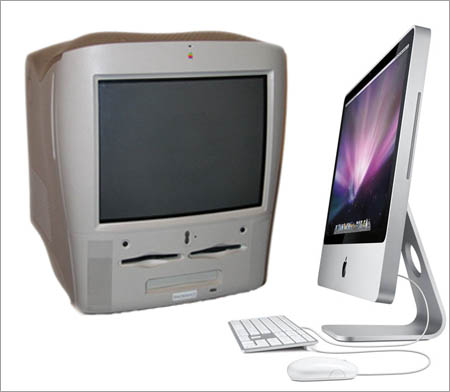This article is more than 1 year old
Sons of Macintosh - shaking the Apple family tree
The Jesus Phone is not divine
Teeth and Sno Balls
iMac: The 20-inch and 24-inch iMacs ($1,199 to $2,199) are the direct descendants of the original all-in-one Macintosh of 1984. Over the years the all-in-one concept has morphed into multiple shapes and sizes, including such notables as the rare, education-market-only Power Macintosh G3 All-in-One (affectionately known as "The Tooth" for its ungainly mega-molar shape); the original gumdrop iMac, which jump-started Apple's Lazarus act when it appeared in 1998; and the second-generation iMac, which for all the world looked like a vanity mirror hinged to the top of a giant Hostess Sno Ball.

The Tooth and the iMac
The current iMac is the best of the all-in-one lineage. Its 45nm Penryn-class Intel Core 2 Duo processor and 1066MHz FSB make it plenty fast for most mid-level tasks, and its graphics performance is more than merely tolerable, especially in the top configuration, which includes a 512MB Nvidia GeForce 8800 GS graphics subsystem. Unfortunately, though, upgrading anything other than its RAM is a bee-atch.
In addition, know that the 20-inch model's glossy display is noticeably inferior to that of the 24-inch model. The 20-incher is only a 6-bit active matrix TFT (the 24-inch display is a full 8-bit unit) and thus achieves its claimed "millions of colors" by dithering. Also, images displayed on the 20-incher suffer from contrast and color shifts when viewed from an angle.
Finally, both models are available only with glossy displays, which tend to over-saturate color and overemphasize the depth of blacks. If you're a pro photographer, you won't be happy, but if you just want your snapshots of Junior to honor the perfect pinkness of your sweet li'l angel, you'll be pleased as punch.
20-inch iMac: B-
24-inch iMac: A-
Mac Pro: In years past, the performance differences between desktop and tower Macs were minor - in some cases, in fact, even as recently as the Power Mac G5 and iMac G5 in mid-2004, there were no differences at all in processor power.
Those days are gone.
Today's base-model iMac is powered by a single dual-core Intel Core 2 Duo. The base-model Mac Pro is equipped with dual quad-core Harpertown-class Intel 5400-series Xeons, each connected to the system controller over its own independent 1600MHz FSB. On the gridiron, that'd be Oklahoma Panhandle State versus the Crimson Tide.
Eight high-speed 45nm cores provide a pile o' processing power. Too bad the Mac Pro can rarely take advantage of it all. Why not? Two reasons - and Apple has an extra-cost solution for one and is working on a remedy for the second.
The first problem: A base-model Mac Pro ships with a single 7,200rpm hard drive that doesn't have a ghost of a chance of keeping eight hungry cores fed. The second problem is the dirty little not-so-secret that it's the rare Mac application that can distribute its tasks efficiently over eight concurrent threads.
Apple has two answers to the first problem - a cheap one and a not-so-cheap one. Cheap: Mac Pros have four easily accessible drive bays into which you can stuff four SATA drives and RAID 'em up using Mac OS X's Disk Utility. Not so cheap: If you want speedier throughput, pop SAS drives into those bays and hook them up to Apple's $800 Mac Pro RAID Card (which also adds a 72-hour backup battery). By the way, the next time an Apple rep gives you a Mac Pro demonstration, it's a good bet that there'll be a Mac Pro RAID Card connected to four SAS drives in the configuration he or she is demoing - that's what the Mac Pros were equipped with at the last Macworld Expo.
The second problem - dumb apps - is trickier, and the one that Apple's focusing on as it works on the next iteration of Mac OS X, Snow Leopard, scheduled for release sometime next year (look for it later rather than earlier, natch). Snow Leopard will include a technology called Grand Central that Apple claims "makes it much easier for developers to create programs that squeeze every last drop of power from multicore systems." We'll see.
The Mac Pro would be a more-attractive buy if Apple would sell you one with no drives nor RAM (it ships with a measly 2GB of the latter in two 1GB FB-DIMMs). Any Mac Pro worth his or her jumpers could stuff a Mac Pro with drives lying around the office, studio, workshop, or supply closet. Also, the price Apple demands for RAM is Pentagon-procurement ludicrous: a cool $9,100 for the eight 4GB FB-DIMMs needed to bring the Mac Pro up to its full complement of 32GB.
Remember the aforementioned "third-party ecosystem?" Well, members of that merry band will sell you eight fully warranted, in-thermal-spec 4GB FB-DIMMs for a lot less. Veteran vendor Other World Computing (www.macsales.com), for example, will max out your Mac Pro's RAM for a measly $1,479.99 - and, no, that's not a misprint. We checked.
All in all, the Mac Pro is a nice box. It's much quieter than its predecessor, the Power Mac G5 (which had fan noise so glaring that on-mic audio work was impossible), it's built like a brick, and its (few) upgradeable components are easily accessible. Let's hope Snow Leopard helps it reach its full potential.
Mac Pro: B+
